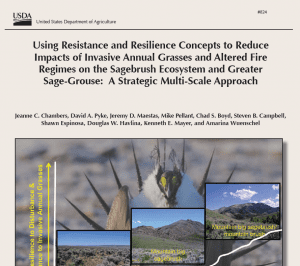Research and Publications
View article.
This study proposes using the principles of risk analysis to provide land management agencies, first responders, and affected communities who face the inevitability of wildfires the ability to reduce the potential for loss. Overcoming perceptions of wildland urban interface fire disasters as a wildfire control problem rather than a home ignition problem, determined by home ignition conditions, will reduce home loss.
View article.
This Science article reports on a growing body of research challenging the widespread notion that beetle-killed forests are more vulnerable to more severe fires than those that have escaped infestation. The findings are highlighting the complex causes of western wildfires and raising new questions about the efficacy of some fire prevention policies, such as plans to remove beetle-killed trees from vast swaths of forest.
View fact sheet.
This fact sheet from the Sage Grouse Initiative discusses a new soils product that provides the ability to depict potential ecosystem resilience and resistance across the range of sage-grouse using soil temperature and moisture regimes.
View report.
This report provides a strategic approach for conservation of sagebrush ecosystems and greater sage-grouse that focuses specifically on habitat threats caused by invasive annual grasses and altered fire regimes. It uses information on (1) factors that influence sagebrush ecosystem resilience to disturbance and resistance to invasive annual grasses and (2) distribution, relative abundance, and persistence of sage-grouse populations to develop management strategies at both landscape and site scales.
View article.
In the op-ed piece, Two Wildfires Everyone Should be Talking About, Wally Covingtion director of the Ecological Restoration Institute and professor of forest ecology at Northern Arizona University, suggests that by acting quickly and at larger scales, forest health can be restored and resiliency be built so that forests are better prepared for whatever changes may occur in the future.
View brief.
This brief highlights a study that found rodents foraged differently in burned and unburned areas. They took seeds and ate seedlings from unburned areas. They were more likely to leave seeds and seedlings in the burned areas.
View fact sheet.
This fact sheet summarizes findings from a study comparing insect populations in burned and unburned areas. The study showed greater reproductive success for isolated plant survivors of generalist species, and less success for specialist species. The more specialized your reproductive strategy, the harder fire is on your sex life.
View memorandum.
This presidential memorandum outlines federal efforts and steps to reverse pollinator losses and help restore populations to healthy levels. The steps include the development of new public-private partnerships and increased citizen engagement.
View article.
This study analysed the role of defensible space by mapping and measuring a suite of pre-fire variables for 1000 destroyed and 1000 surviving structures for all fires where homes burned from 2001 to 2010 in San Diego County, CA, USA. Structures were more likely to survive a fire with defensible space immediately adjacent to them. The most effective treatment distance varied between 5 and 20 m (16–58 ft) from the structure, but distances larger than 30 m (100 ft) did not provide additional protection, even for structures located on steep slopes. The most effective actions were reducing woody cover up to 40% immediately adjacent to structures and ensuring that vegetation does not overhang or touch the structure.
View article.
This study summarizes data from extensive monitoring (2003-12) of sage-grouse populations within the Bi-State DPS. Data regarding lek attendance, movement, and survival of sage-grouse across multiple life stages were documented. A hierarchical integrated population modeling (IPM) approach was used to derive demographic parameters, which allows for the integration of multiple data sources to inform population growth rates and population vital rates.


